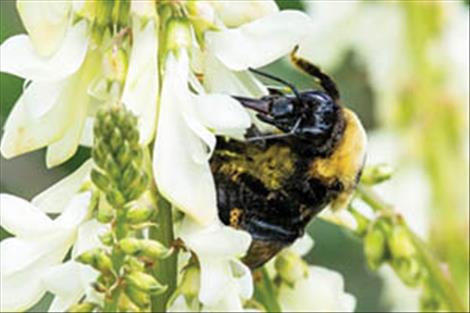Local pollinator initiative branches out
Hey savvy news reader! Thanks for choosing local.
You are now reading
1 of 3 free articles.
The Lake County Conservation District is expanding its pollinator initiative this year, bringing the movement into urban Ronan.
The local pollinator initiative began in 2017 when district board member Susan Gardner brought up her concern about the bees. A sheep farmer with a deep interest in agriculture and flowers, Gardner pointed out how quickly pollinator habitat is being removed over large areas.
One of the concerns the conservation district has had to face is the risk that comes with native bumble bees being put on an endangered species list. While not necessarily an upcoming risk in Montana, it has already happened on the east coast. District Conservation Coordinator Heidi Fleury explained.
“When native bees are put on the endangered species list, it starts to put limitations on what can be done with the land,” Fleury said. “So, to keep ag lands and production, it’s important to keep all the pollinators off the endangered species list.” Areas that have had their bees added to the list have seen restrictions and new regulations in both chemical spraying and systemic insecticides, making it more difficult to fend off aggressive plants that encroach on seeded land.
Gardner wrote the pollinator resolution used by the conservation district, and it was sent off to the statewide organization. The first in the state to propose such a resolution, they became the pilot program for the state of Montana. Working with the local U.S. Department of Agriculture (USDA) service center for the Natural Resources Conservation Service (NRCS), they were able to create seed mixes of flowering plants to be given out to landowners to increase pollinator habitat and began working on education and outreach.
“It’s important for so many reasons,” Fleury stated. “It’s a larger issue, so we’re trying to deal with it on a local level.”
The district has prioritized education, spreading the word about threats to native pollinators. One such method has been through their ongoing conservation speaker series. In an upcoming presentation on March 30, Janene Lichtenberg of Salish Kootenai College will share her bumble bee research gathered over the last few years in the Mission Mountains.
So far, Lichtenberg and her team have identified 15 different species of native bumble bees on the Reservation alone, with an indeterminant amount yet to be found. A study conducted by one of her students even revealed that native bees prioritize gathering pollen from native species of flowering plants over invasives such as knapweed, despite their abundance.
“People sometimes forget, or aren’t even aware, that there’s this huge number of native bees and some are essential for our native flowers,” Lichtenberg said.
Outreach with farms and ranches has also been a high priority. The district gives away wildflower seed for smaller plots, but they have also worked on landscape-level projects for different producers that graze animals. For those, they use cover crops with flower species within them that can also be grazed in the fall, a nice bumper crop that helps with habitat without taking land out of production.
Over the years, the conservation district has contributed to 720 acres in pollinator habitat. They’ve conducted 5-acre studies in irrigated pastures where they interseeded legumes to add diversity to the pasture and add flowering species. Now, they’re looking to contribute to the urban landscape as well.
Thanks to a grant from the state, the district has been able to buy plants to coordinate with ten different businesses throughout Ronan to bring native wildflower pollinator gardens into town.
Sage Jibben, a part of the conservation district who also belongs to Americorps, has been recruiting volunteers for the planting scheduled for the third week in April. They like to do planting around Earth Day as the warmth and spring moisture gives seedlings the best advantage. The planting follows Pollinator Week, which will be held during the first week in April. During Pollinator Week LCCD sets up seed pick up locations in Polson and Ronan and pollinator trivia nights at the breweries.
“I’m excited to see it happen. I’m excited to see all the flowers blooming,” Jibben said. “I’ve been getting everything ready, bagging up and mixing the seed, so it’ll be interesting to see what grows from those seeds.”
Working within the limits of the grant funding they received, Fleury speculates they could potentially work with up to 15 different businesses if they were to implement a small cost share for plants. “I think it would be so cool if there were a bunch of wildflower plots in front of all the local businesses,” Fleury said.
In the last couple years Fleury says interest in pollinator conservation has grown. As the state’s pilot program, the Lake County Conservation District received a grant to allow Fleury to visit other conservation districts throughout the state to promote their own pollinator initiatives. Out of the 58 conservation districts in the state, 20 have now followed Lake County’s lead.
For those who would like to contribute to pollinator habitat by planting or volunteering, contact Fleury at 406-676-2841 ext. 102, or at lakecountycd@ronan.net. Learn more ways to get involved and help the bees at https://lakecountyconservationdistrict.org/pollinator-initiative.
















